Many people are purchasing air conditioners that fit into a window because they’re cheaper than portable units or central air.
However, most of these units are designed to fit vertically opening windows.
If you have horizontal sliding windows and want a window AC, you may have noticed that ACs made for this type of window are significantly more expensive.
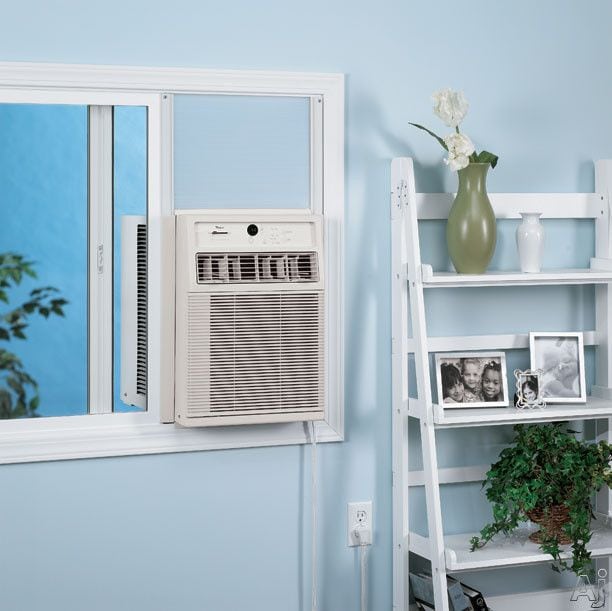
Photo credit: thatsnerdalicious.com
Quick Questions Before Starting
It’s possible to adapt ACs made for vertical windows to fit in a sliding window. If you live in an apartment or if you only need an air conditioner a few months of the year, this is a perfect solution for you.
How Difficult is This to Do?
- Installing the AC unit is about a medium difficulty level; however, it’s best to have a friend help you lift your air conditioner and hold it in place.
How Long Does it Take?
- This project will take you approx 1:30.
How Much Do Materials Cost?
- Depending on the supplies you already have, this project will cost you $250-$700.
Items Needed
Here’s a list of all the items you'll need to complete this project and their estimated price. Many people already have some of the tools necessary to complete this project. If not, you can pick them up at any local hardware store.
- A box of screws: $8.97
- Electric drill: $50
- A Phillips and flat-head screwdriver: $14.97
- AC unit: $150
- An assistant
- Measuring tape: $14.97
- Scissors: $6.97
- Wrench: $19.97
- Ladder (optional): $80
- Weatherstripping: $8.48
- Total: $354.33




Photo credit: thriftyfun.com
How To Install a Window AC Unit In a Horizontal Sliding Window
Before starting on the project, make sure to measure your air conditioner's width and height. Include any vents that might stick out on the sides, as well as the height of the window’s opening.
Choosing a Window
The window should be near a three-pronged outlet—using an extension cord may not provide enough power for the unit to function properly. Inspect the windowsill; if it’s old, weak, or shows signs of damage, it may not support the unit's weight. You’ll need to replace the windowsill or select a different window.
Weatherstripping
Cut a piece the same width as the window’s opening. Follow the instructions to place the weatherstripping correctly and adhere it to the windowsill so that the unit will be on top of it when in place. Firmly press the weatherstripping to help it adhere to the windowsill.
Support Brackets
With an electric drill or screwdriver, secure the bracket to the ledge of your window with screws. Check to see if your AC needs a tilt or any leveling. Depending on your unit, either use a level to make sure the brackets are straight or angle them between 1/4 and 1/2 inch.
The instructions included with your air conditioner will show you how to assemble the bracket, if it’s pre-assembled, and where to install the bracket along the windowsill. To prevent the AC from falling out the window on either side, you should place a bracket in the center of the windowsill.
Depending on your unit's size and weight, the exterior bracket may attach just below your windowsill or further down the side.
Assemble the AC Unit
You might need to attach air conditioner panels along the sides and top of the unit. The panels will attach with screws; any special tools you need should come with the AC unit. These panels frame the AC and prevent warm air, allergens, and pollution from entering your home. You can add weatherstripping on the sides of the panels to create an air-tight seal.
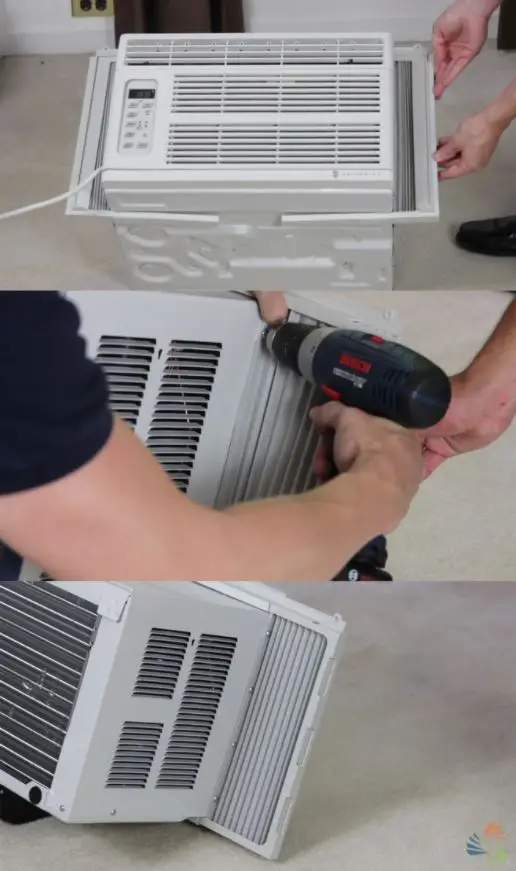



Photo credit: sylvane.com
Closing the Gap
Subtract the height of your unit from the height of your selected window. You can cover this gap with the plastic curtain that comes with your AC unit. Cut the plastic curtain with scissors to cover the gap between the unit and the top of the frame.
For example, if the unit is 30 inches high and the window opening is 50 inches tall, cut the curtain to 20 inches in length. Slide the curtain into the frame that came with the unit, and attach it to the unit, sliding the frame neatly into the side panels.
Attach the frame to your air conditioner using a screwdriver; if necessary, some units slide into place.
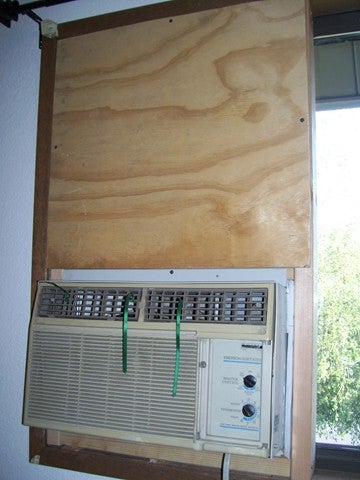



Photo credit: instructables.com
Place Your Air Conditioner
Slide the air conditioner into the window opening until it rests against the support bracket. Ask someone to help you lift the unit and hold it in place. Use a screwdriver to attach the AC unit to the bracket.
It may be easier to do this from the outside of the building, rather than trying to work around the unit. The bracket will attach with one or more screws in the back of the AC unit.
Securing the Unit
Drill holes through the unit's bottom panel into the window’s track, using the screws to attach the AC unit's base to the window. Attach the curtain frame to the sides of the window by pre-drilling holes with an electric drill and using a screwdriver to tighten the screws.
In the bottom corner of your window, where it meets the jamb, line up the L bracket with the AC's base. Drill into the hole of the L bracket into the window frame, keeping it in place. This bracket will stop anyone from opening the window from the outside.
Enjoy Your AC
Plug your unit in and wait for your room to cool off.
Tips and Safety Considerations When Installing a Window AC Unit In a Horizontal Sliding Window
- When purchasing an AC unit, look for an energy efficiency rating (EER) of 10 or more for better efficiency. It's also important to know the British thermal units (BTUs) of the AC. If your unit doesn't have the correct amount of BTUs, it won't reach desired temperatures, or it'll turn on and off too quickly, leading to an uneven temperature in the space. Check the box to see the manufacturer's recommended room size; you can also find online tools to find how many BTUs your room requires.
- Some AC units require a tilt to prevent condensation from dripping down the wall inside your home. The tilt should be no more than half an inch, but check the installation guide for the manufacturer's recommendation. Other units don't require a slant; they have a drip pan inside them at an angle to collect the condensation.
- Window air conditioners weigh between 50 and 100 pounds, so lifting the appliance and holding it in place while securing it with screws definitely requires assistance. You may injure yourself or accidentally drop the unit out the window if you try and install an AC by yourself.
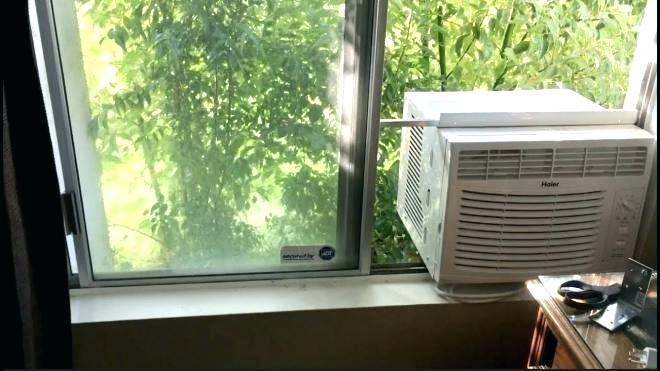



Photo credit: theairgeeks.com
Common Issues
Be on the lookout for these common problems with installing a window AC in a horizontal sliding window.
Size
The most common problem is installing a unit of the wrong size. The most efficient and effective window air conditioner has a cooling capacity of 20 BTUs per square foot of space in the room.
If your desired room has high ceilings or is in direct sunlight, you may need a slightly larger capacity—bigger is not always better. An oversized unit in a small room won’t cool better than a smaller unit. A smaller AC running for a longer time is more efficient than a larger unit turning itself on and off repeatedly.
Weight Distribution
It may be tempting to open the window, slide the air conditioner in, and close the window firmly onto the unit. Doing this forces the window and the window sash to bear the weight of the air conditioning unit and can cause damage to the window. When installing your AC unit, take the time to attach brackets to help support and distribute the air conditioner's weight.
Tilting
Air conditioners cool air by removing moisture from it, causing water to pool inside the AC and drain from the back. Some air conditioners have gutters and channels built into them, allowing them to drain when the unit is level. Others require a slight tilt for the AC to drain correctly.




Conclusion
Window-mounted air conditioning units are a cost-effective alternative to central air that can provide immediate relief on a hot day. Make sure that your window unit is the correct size for your window and has adequate support. Ask a friend to help you to prevent personal injury and damage to the unit.
People Also Ask
Window air conditioning units provide cooling to any room in your home. When the air conditioner is no longer needed during seasonal weather, you can easily remove it, and your window will be fully operable. However, many people have questions before they install their AC units.
How Do I Secure an AC in a Horizontal Sliding Window?
To secure an AC unit, make sure to install its support brackets. Secure them to the window frame and the house's side.
Use wooden screws if your frames are made of wood or vinyl, and if you have metal frames, use siding or sheet metal screws.
Adding L brackets prevents the window from being opened inadvertently, decreasing the risk of the unit falling out of the window.
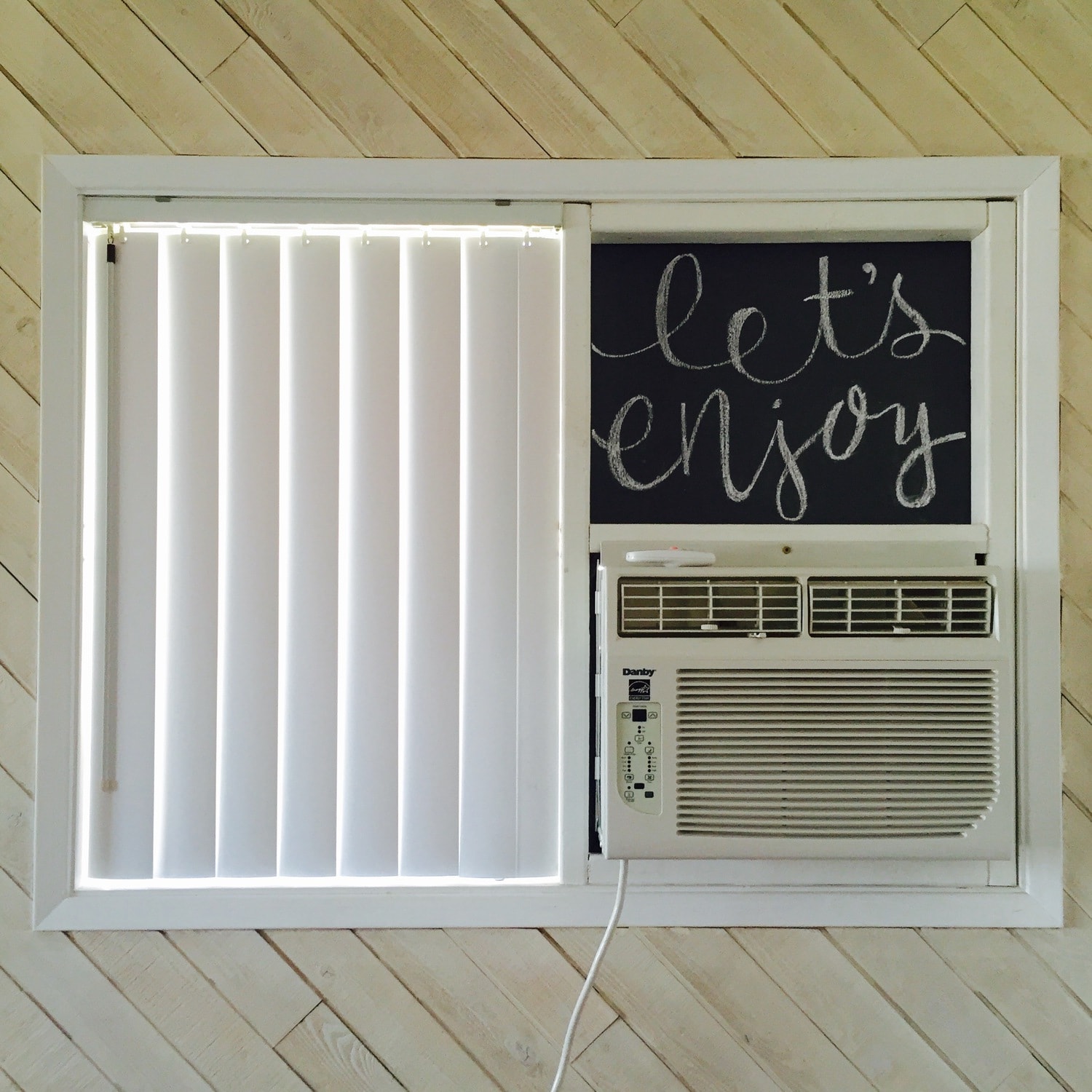



Photo credit: thehowtoduo.com
Is it Safe to Have a Window Unit in a Horizontal Sliding Window?
There are some great options for adding security to a window with an air conditioner. A quick fix is to grab an old stick, broom, piece of wood, or whatever you have lying around.
Cut it to fit the track of your window to prevent it from being opened. You can also try a sliding window lock; they're little locks that you fix onto the window's sliding track to block it from opening. However, these are difficult to remove in case of an emergency.
Are Window AC Units Allowed in a Horizontal Window in a Neighborhood With an HOA?
In most single-family homes, you can install a window AC. However, if you live in a condo, an apartment, or a neighborhood with an HOA, check with your HOA board or landlord before buying a window AC unit.

